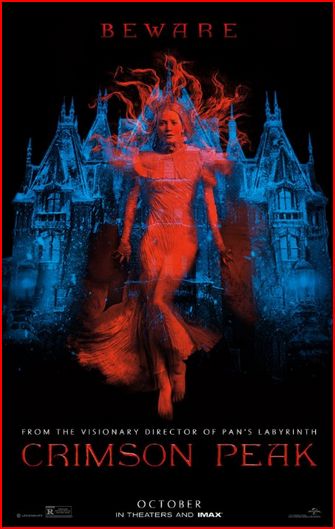
Rest assured, reader, that Edith is free to join her love across the ocean at Crimson Peak when her dad's head is bashed in by a mysterious assailant in his club washroom. Sharpe and his hostile sister (Jessica Chastain) live in a preposterous mansion, majestic in its isolation like The Shining's Overlook Hotel or the Benedict house in Giant, that seems not only to breathe but bleed; red clay seethes beneath the soil and the Sharpes hope to recover their family fortune harvesting it with modern machinery. Sister Lucille took a dislike to Edith back in America; at home she's the sort of complication you expect a Gothic mansion to have, and there's no more I can say about her that won't spoil the story.
Not satisfied with his pastiche and homages, del Toro strives to put his signature on the piece by making the various ghosts our heroine encounters the sort of creatures you see in a del Toro picture. Call them guillermites, if you will, and while I had to laugh at one particularly idiotic review that complained that ghosts shouldn't look like that, I must admit that the director's characteristic creations did seem a bit like alien superimpositions on an imagined 19th century. That's just a quibble, however, while the abundance of glaring clues to the truth of household arrangements past and present at Crimson Peak is a more serious weakness of the film. There's more Shining influence to be found in this film's climactic chase and combat in the snow, and in the long trek of a supporting character in order to get stabbed, while the involvement of two women in the combat arguably hearkens all the way back to The Archers' Black Narcissus, which was something of a stylistic influence on the Kubrick film. Crimson Peak is indeed rich in allusions for film buffs, but the general audience is more likely to be won over by the committed acting of the three leads, so long as they have more patience for the screenplay's novelistic pace than some reviewers have shown. I've seen several writers complain that the film is all buildup and little payoff, but I suspect that's short attention spans talking. Despite its up-to-date special effects Crimson Peak is an old-fashioned film in many ways, most of them good ways. Whatever its flaws, it's a welcome alternative to the latest found footage and other cliches that pass for horror these days, and its old-fashionedness may prove more of a virtue for Halloweens to come.
1 comment:
Yey again our viewings line up. I too was pleasantly surprised, especially since I didnt care much for Pan's Labyrinth. My site colleague Maurizio Roca liked it (surprisingly) and I was mostly ravished. The head smashing in the bathroom was pretty revolting though. Great review here!
Post a Comment